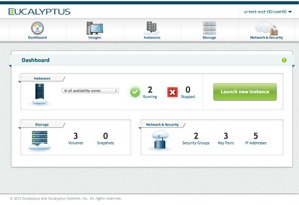It’s been less than half a year since Eucalyptus rolled out version 3.1 of its open cloud platform, but on Monday a brand-new Eucalyptus 3.2 made its official debut.
Included in the new release are a graphical cloud user console, extended Amazon Web Services (AWS) compatibility, new management capabilities, and a hardened node controller.
 “Eucalyptus 3.2 delivers a highly reliable and robust private and hybrid cloud solution that empowers both enterprises and the open source community to confidently deploy applications and drive innovation in the cloud,” said Marten Mickos, CEO of Eucalyptus, in the official announcement.
“Eucalyptus 3.2 delivers a highly reliable and robust private and hybrid cloud solution that empowers both enterprises and the open source community to confidently deploy applications and drive innovation in the cloud,” said Marten Mickos, CEO of Eucalyptus, in the official announcement.
Linux.com had an opportunity recently to speak with Andy Knosp, the company’s vice president of product, about the new release.
Self-Service Provisioning
“Really the anchor feature of this release, which points to greater ease of use, is the new Web-based console,” Knosp told Linux.com.
The console provides a Web-based graphical user interface that enables self-service provisioning of compute, network, and storage resources for cloud users, Knosp explained.
With it, users can perform self-service operations including the provisioning of instances, keypair and password creation, Elastic Block Store (EBS) volume and snapshot operations, image catalog listing and registration, user group operations, and elastic IP operations, for example.
Expanded Storage Options
Also new in Eucalyptus 3.2 are expanded storage options through two new adaptors. The new JBOD Storage Adaptor, for example, overlays EBS functionality on top of raw block devices and JBODs, and provides full support of AWS EBS API operations, Knosp said.
The EMC VNX SAN Storage Adaptor, meanwhile, provides expanded SAN support for EMC VNX Series SANs for EBS storage, including high availability for the Eucalyptus Storage Controller, advanced VNX snapshot support, and multi-pathing support for greater redundancy.
Then there are new reporting features designed to give cloud administrators better insight into cloud usage. Using these new tools, administrators can report on cloud compute, storage, and memory usage at the user, group, and cloud level, for example, and generate and export reports via the graphical user interface, API, or command line.
“We’re definitely working toward making the experience around cloud administration easier,” Knosp said. “We want to make it easier to identify faults and issues and to simplify the administration of Eucalyptus clouds.”
A Hardened Node Controller
Perhaps most of all, however, Knosp pointed to a companywide emphasis on building a solution that’s consistently production-ready.
Eucalyptus 3.2, for example, has been “tested at length,” he said, and introduces a
hardened node controller that further increases cloud reliability.“Our goal is to be the most tested and stable open source platform on the market.”
Eucalyptus 3.2 will be available next month. Looking ahead, the next Eucalyptus release is now planned for April 2013. Visible in that next iteration will be an increased focus on adding AWS services like elastic load balancing, autoscaling, and other app-level services, Knosp said, as well as further expanded infrastructure options for deploying Eucalyptus.
One thing that won’t change, however, is the company’s commitment to the open source approach. Simply put, “we think this is fundamentally the best way to build software,” Knosp concluded.



